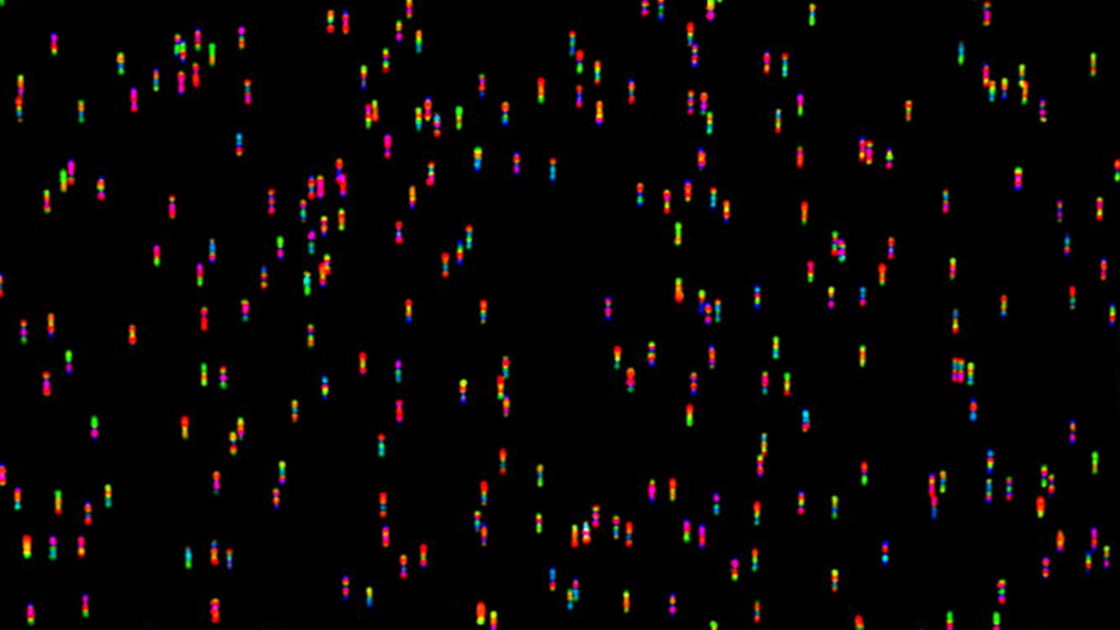
Gx Profiling Made Easy: The Birth of nCounter®
Nanostring: noun; a piece of DNA (probe) attached to a linear sequence of fluorophores made up of four different colors (barcode). Each probe is complementary to a unique target oligonucleotide.
This is what the original NanoStringers Dwayne Dunaway and Amber Ratcliffe decided to call their DNA probes.
Back in 2002, the prefix “nano” had a futuristic sound to it, and a probe made up of a string of nucleic acids became a ‘string’, and just like that, the name of the company that would become NanoString Technologies came into being. Dwayne confessed that he complained to Amber about the time spent coming up with a name for this newly funded startup. Little did he know that it would become an important name in life science and the foundation for a brand-new gene expression profiling technology as well as the field of spatial biology.
The Road to Simplified Gene Expression Analysis: The Beginnings
The founders of NanoString® came from the Institute for Systems Biology (ISB) here in Seattle, Washington. One of them, Dwayne Dunaway, was fresh out of graduate school where he learned about how muscles stretch, or more precisely, how molecules inside muscles stretch. If you know something about how the nCounter technology actually counts individual RNA or DNA molecules, you can see how this knowledge about ‘stretching’ came in handy.
In 2001, Dwayne met Krassen Dimitrov while interviewing at ISB for a postdoctoral position. During the interview, Krassen who at the time was the Director of Microarrays at the ISB, told Dwayne about a new technology they had developed and already patented that could change the way gene expression analysis was done. Dwayne saw how he could improve the technology and joined the team.
For the next two and a half years, the team at ISB achieved three goals before getting funding for ‘NanoString’: they managed to “make the nanostrings, stretch the nanostrings, and image the nanostrings.” The stretching part took a lot of tricky surface chemistry. The team had to develop a suitable surface that the nanostrings would attach to.
At the same time, one of their colleagues, Amber Ratcliffe, left ISB to go to business school and proposed that they participate in a business competition. Their work paid off and enough people believed in the technology that Amber and her business partner Aaron Coe won enough cash to start the company.
Before We Continue with Our Story, What is a “Nanostring”?
Dwayne and Krassen were trying to build probes targeted to specific gene transcripts that were large enough to (1) carry a unique fluorescent barcode and (2) link to a biotin molecule so the complex could be captured on a streptavidin-coated surface (biotin is a small molecule that binds strongly to streptavidin protein). Once hybridized to a target transcript, these probes could be electrically stretched on a surface, imaged, and counted. Today, the nCounter® Digital Analyzer scans and digitally counts in a certain field of view each fluorescent barcode hybridized to an RNA or DNA molecule and adds up all the counts for a relative quantification of gene expression in a single sample.
A Picture is Worth a Thousand Words: Evidence that Convinced the Investors
In those early days, the technology was far from being optimized but the NanoString team knew they had a great technology that would simplify the laborious, high-throughput expression analysis done on a microarray. They just needed to find and convince some investors that they were on to something great!
To convince investors, the intrepid NanoStringers had to demonstrate that they could make the nanostrings, purify them, image them, and build a device to support the technology. If you are familiar with the nCounter MAX Analysis System, hybridized targets are stretched on a cartridge in the Prep Station and then counted in the Digital Analyzer. If you look at the images below of what they presented to investors as a prototype cartridge and what a cartridge looks like today, you will notice quite the evolution!
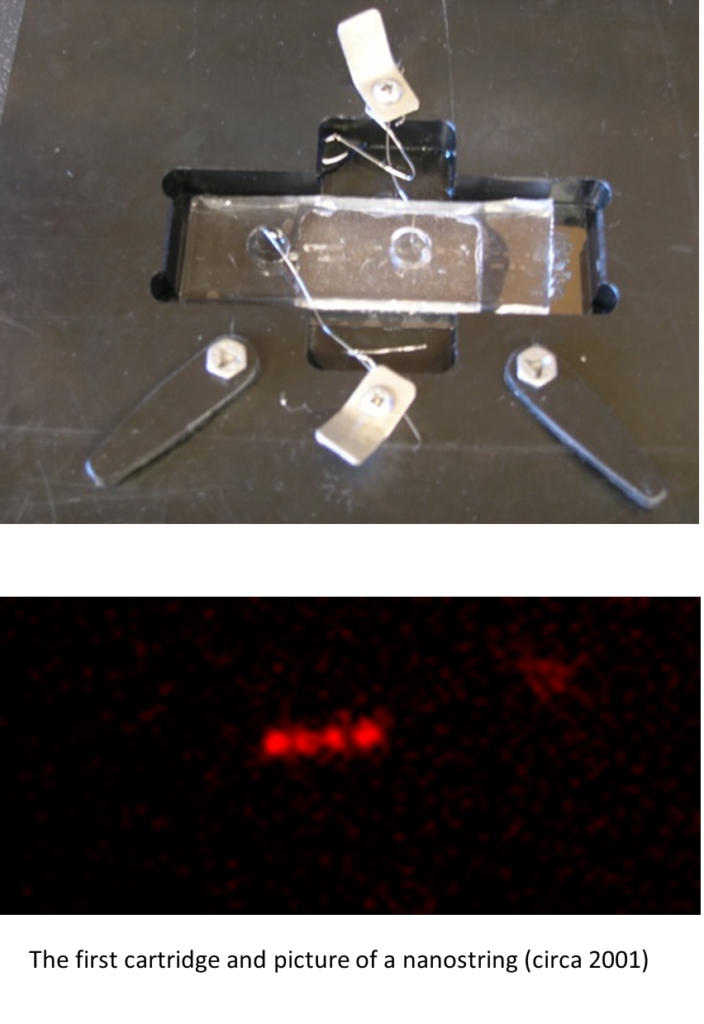
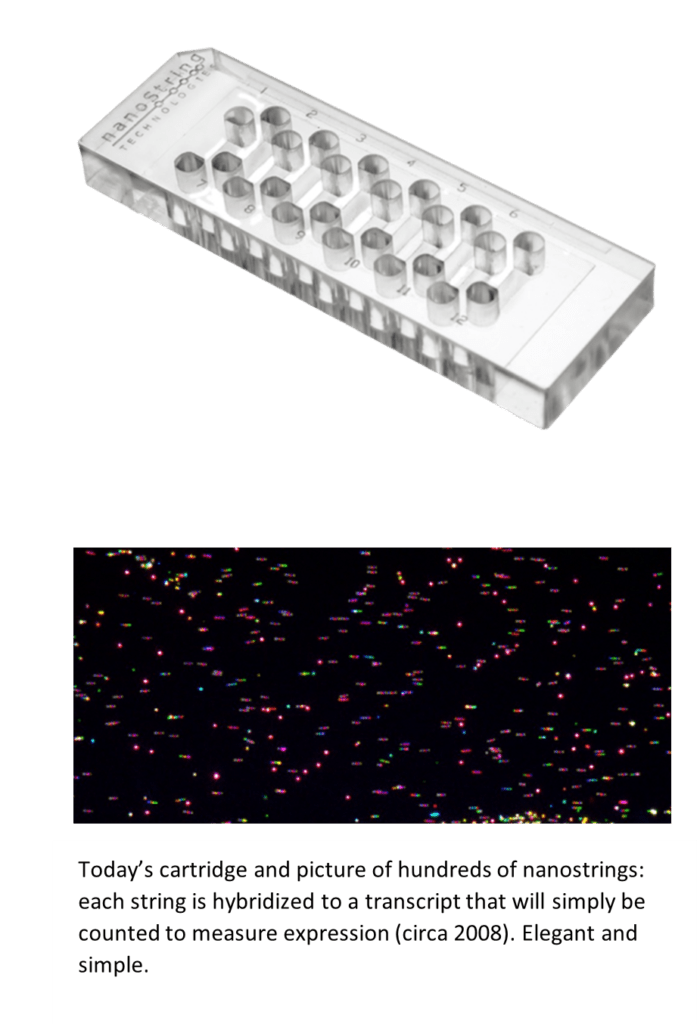
Those early investors bet on the technology, and NanoString was funded. For the first six months, they existed as a one-bay lab inside ISB, hosting a few people before moving to a new building, hiring more people, and buying lab equipment. Some of the early hires were critical to the success of NanoString: Gary Geiss, Philippa Webster, and Sean Ferree joined Dwayne Dunaway early on. These fantastic four led the company for the first four years before other vital players like Rich Boykin and Michael Wotring joined in the mid-2000s.
A 2004 article on CNN Money from FORTUNE Magazine predicted a bright future for the young company.
Still a Long Road Ahead
When Sean Ferree joined NanoString, the technology was still in development. He found the technology promising: the concept of fluorescent barcodes and digital counting bypassed the challenges of microarrays: time-consuming bench work, enzymatic reactions, and a lack of robust quantitation with analog data. The NanoString device could be an exciting and much-needed resource in the early days of microarrays analysis. Sean was on-board and moved to Seattle.
When he started working, he realized that some improvement was needed to make the technology marketable. The team wanted to develop a technology able to analyze the entire transcriptome, and the initial strategy was dual nanostring probes that would allow for profiling the whole transcriptome. One of Sean’s first contributions was to help the team realize that the kinetics of two large nanostring probes finding their target meant that this was next to impossible. One day while walking back to the lab after lunch, Dwayne and Gary were discussing these challenges and concluded that they should optimize the technology for 1,000 plex and worry about the full transcriptome later. Little did they know that they would keep this promise, albeit a decade later and with spatial biology.
The basic structure of the nanostring had to change too. The initial nanostring structure had a six kB backbone like current NanoString probes; but, instead of a linear double-stranded molecule, it had branches coming off a single-stranded backbone, giving it a ‘hairy’ look. These branches consisted of oligos each branch hybridized with a dye molecule. These hairy nanostrings were sticky and not stable in solution. One of Philippa’s biggest contributions soon after she arrived was to figure out how to hybridize RNA to the linear DNA structure probes are currently made from. Key to this was making the 1.1 kB in vitro transcribed fluorescent RNA patches.
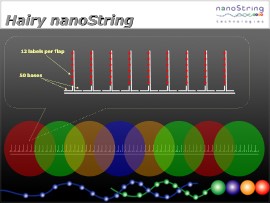
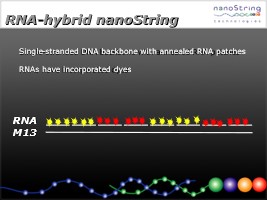
Soon after, Philippa and Gary came up with what we know today as the NanoString barcode structure used in all Panels and Custom CodeSets, which moved us away from an M13 backbone.

The Nanostrings Work. Time to Scale Up.
With the barcode strategy nailed down, the probe sequences had to be sustainably designed, requiring a technology that the young company couldn’t yet afford.
The original computer scripts (Gauntlet) did the work for a while, but the team still had to design CodeSets manually. This system needed automation to decrease human errors and to increase the consistency of probe designs. The original scripts were fixed for bugs and improved, and automation was added to design probes at the transcriptome level – this method was dubbed “Design Them All” (DTA) and is still in use today.
Legend had it that there was still an original server, somewhere, with the old scripts and libraries that no one is allowed to touch because according to Rich Boykin, current Senior Director of Bioinformatics: “if you try to update it, none of those old scripts will ever run again.” Unfortunately, this legendary server retired in late 2021.
Meet the Tiny BLATTER
With the introduction of a Copy Number Variation (CNV) assay, a new bottleneck for designing the CodeSets was BLATing probes against the genome for specificity, copy number, and homology screening.

To overcome the lack of money for sophisticated hardware, Rich Boykin cobbled together some old hardware and made a little 4-node mini-cluster whose sole job was to automate the BLATing of the whole genome. All this little guy did 24/7 was just BLAT probes against the genome and store them in a database.
Today, we are much more sophisticated, and only ~5-10% of the probe selection and building has a human component. Still, the Tiny BLATTER is a testament to the grit and ingenuity of the first intrepid NanoStringers.
The Launch
The first nCounter System was shipped in 2008, and in 2021 we sold our 1,000th nCounter instrument! Remember how hard it was to design CodeSets? Today we have all kinds of pre-defined gene expression panels covering all different research areas from Immuno-oncology to Neuroscience and Infectious Diseases, and we still design between 1,500-2,000 Custom CodeSets every year. The young scientists who worked at ISB fulfilled their promise to simplify gene expression profiling: with only 15 minutes of hands-on time, the nCounter Analysis System gets you publication-ready results in less than 24 hours without the need for technical replicates.
But the NanoString story didn’t stop there. In 2019, we started mapping the universe of biology and entering the Spatial Biology era with the advent of the GeoMx® Digital Spatial Profiler. And today, we are going beyond with the CosMx™ Spatial Molecular Imager, the first spatial biology platform to offer single-cell and subcellular resolution multiomics for FFPE samples. And we keep going up.
In Dwayne’s words, it’s “a little bit like climbing a mountain. You look at the mountain and you say, Woah! How am I going to do this? but then you start doing it, one thing after the other until you find yourself at the top.”
How will you climb to the top of your research goals with NanoString technology by your side?
For Research Use Only. Not for use in diagnostic procedures.


